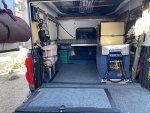Chorky
Observer
I know there has been lots of discussion on the topic, but I finally have a direction - after all these years.
After looking at some options, I think I have concluded that no current ready to go system (Jackery, goal zero, or equip mobile battery box) will suit my needs. So I probably will be having to build my own - as much of a pain as that is. After reading several sources (and researching other options in the past for other vehicles I have had) I concluded that a 200ah rating is needed. Even for just a 3 day weekend.
My idea is to have a mobile battery box to house 2 batteries via Anderson connector. Those batteries would be hooked up to a PDC in the bed to power various things like fridge, camp lights, water pump (when not powered by the engine running), air compressor (when not powered by engine running), and maybe charging a phone or two. That PDC would also have wired a DC/DC charger (probably red-arc) so that I could, if desired, switch out battery types if realizing I needed something different. The DC/DC charge indicator circuit (connects to a 'key on, engine on' circuit) would also be wired through a relay of one of the factory aux switches so it would have to be manually powered on, in order to close the circuit that recognizes the 'key on, engine on' signal. This way, batteries could be removed and the DC/DC charger would remain "OFF" since no batteries are connected, and thus electrical charge power is not needed.
So, only the batteries would be 'removable' as the system would essentially be designed to be permanently in the bed. I suppose the system could also be in the cab, but my truck and TJ usually gets upwards of 130 degrees in summer sun on a daily basis..... Not good for batteries.
The need for a mobile system (or mobile batteries) is real considering cold winter temps for 6 months out of the year, so an onboard system of lithium batteries won't work without risking damage to expensive batteries. I would honestly much prefer AGM batteries and just leave them in the bed all the time. However, I think in order to have the battery capacity I need for a 4 day weekend trip once a month, AGM would not last long enough...
So I would love to see other folks current on-board set-up's. I'm really not interested in something like a Jackery or goal zero. Because of their proprietary and integrated circuits they simply won't work for my application and I have seen many people showing real world experiences of those systems simply not working even for a fridge due to the 'start-up' voltages being high and the integrated system shutting down for protection - thus, no working fridge after just a couple hours. No offense to anyone who is successfully using one of those systems.
Curious to see what folks here have success with.
After looking at some options, I think I have concluded that no current ready to go system (Jackery, goal zero, or equip mobile battery box) will suit my needs. So I probably will be having to build my own - as much of a pain as that is. After reading several sources (and researching other options in the past for other vehicles I have had) I concluded that a 200ah rating is needed. Even for just a 3 day weekend.
My idea is to have a mobile battery box to house 2 batteries via Anderson connector. Those batteries would be hooked up to a PDC in the bed to power various things like fridge, camp lights, water pump (when not powered by the engine running), air compressor (when not powered by engine running), and maybe charging a phone or two. That PDC would also have wired a DC/DC charger (probably red-arc) so that I could, if desired, switch out battery types if realizing I needed something different. The DC/DC charge indicator circuit (connects to a 'key on, engine on' circuit) would also be wired through a relay of one of the factory aux switches so it would have to be manually powered on, in order to close the circuit that recognizes the 'key on, engine on' signal. This way, batteries could be removed and the DC/DC charger would remain "OFF" since no batteries are connected, and thus electrical charge power is not needed.
So, only the batteries would be 'removable' as the system would essentially be designed to be permanently in the bed. I suppose the system could also be in the cab, but my truck and TJ usually gets upwards of 130 degrees in summer sun on a daily basis..... Not good for batteries.
The need for a mobile system (or mobile batteries) is real considering cold winter temps for 6 months out of the year, so an onboard system of lithium batteries won't work without risking damage to expensive batteries. I would honestly much prefer AGM batteries and just leave them in the bed all the time. However, I think in order to have the battery capacity I need for a 4 day weekend trip once a month, AGM would not last long enough...
So I would love to see other folks current on-board set-up's. I'm really not interested in something like a Jackery or goal zero. Because of their proprietary and integrated circuits they simply won't work for my application and I have seen many people showing real world experiences of those systems simply not working even for a fridge due to the 'start-up' voltages being high and the integrated system shutting down for protection - thus, no working fridge after just a couple hours. No offense to anyone who is successfully using one of those systems.
Curious to see what folks here have success with.


